Ultra-Light Guru Photon – Installment 3, Drivetrain
by Jim Weaver, Service Manager, Fit Werx VT
DRIVETRAIN
As I stated previously, we wanted to build a bike that was reliable, and that could be used every day. We debated a bit about the choice of drivetrain. There are some fairly esoteric components on the market that come in lighter, but going that direction felt like it would really compromise the goal of keeping functionality high on the priority list. Is another few grams really worth having a rear derailleur that is noisy or only sort of shifts? We didn’t feel so. In the end we elected to allow this bike to showcase the current lightweight group leader – SRAM’s new RED. SRAM’s entire RED groupset weighs 1,739 grams, 306 grams lighter than Shimano Dura Ace, and 136 grams less than Campagnolo Super Record. 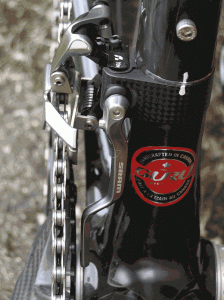
The new SRAM RED 2012 group design has improved several areas of the previous generation RED’s performance. The previous version of SRAM RED was noted for its less than stellar front shifting. Some pro team riders, riding SRAM RED, would even use the SRAM Force front derailleur, because it shifted better than RED. The weight trade-off was worth the improvement. You may have read about the new SRAM RED 2012 front derailleur, as the bicycle world has been flooded with articles about this new design. When shifting, this derailleur does not move outward towards the large chainring in a straight line, as on pretty much every other front derailleur. Rather, it actually twists as it moves outward. SRAM dubs this characteristic “Yaw” and it allows SRAM to do away with any “trim” steps in the front shifting. Push the lever, and it shifts to the large ring, or back to the small ring, period, with no intermediate stops. The derailleur is designed to eliminate chain rub, regardless of the gear selection in the rear, even the dreaded cross-chain combination of large front chainring large rear cog, or small front chainring small rear cog. My experience with this new derailleur is that you may still have a small bit of chain rub if you cross-chain on some short chainstay bikes, but much less than before, and much less than the competition. Besides, you shouldn’t use that gear combination anyway as it will wear out your chain and cassette prematurely. Getting off my soapbox and back to the issue at hand, the new front derailleur is also much stiffer than before. Gone are the previous version’s titanium bits, replaced with steel, which, while a bit heavier, are much stiffer. The new derailleur comes with an elegant integrated and adjustable chain catcher, a great idea, especially for carbon fiber bikes. Remounting my soapbox, I do not understand why bicycle companies do not include a chain catcher on all of their carbon bikes. Even the best adjusted and maintained front derailleur can sometimes throw the chain off on the inside, just ask Andy Schleck, as he arguably lost the 2011 Tour de France for this reason. Judging by the number of scratched and gouged drive side bottom brackets I see, it is a much-needed, ingenious device.
The new SRAM RED chainrings are much stiffer than the previous design. Improved and relocated shift pins on the backside of the chainrings are designed to work best with the new derailleur. The combination of the stiffer derailleur and stiffer, improved chainrings makes for front shifting that rivals or, in some commentators’ opinion, exceeds, the best from Shimano or Campagnolo.
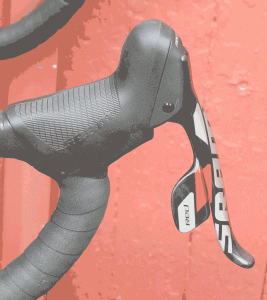 SRAM has made many modifications to the shifters themselves. Shifting, particularly to the rear, is quicker, with less lever motion, and the action feels lighter in back-to-back comparisons with the previous generation of RED. SRAM has of course retained its “Double Tap” design, so unlike Shimano or Campagnolo, a single lever controls both the up shifts and down shifts. No fumbling w
SRAM has made many modifications to the shifters themselves. Shifting, particularly to the rear, is quicker, with less lever motion, and the action feels lighter in back-to-back comparisons with the previous generation of RED. SRAM has of course retained its “Double Tap” design, so unlike Shimano or Campagnolo, a single lever controls both the up shifts and down shifts. No fumbling w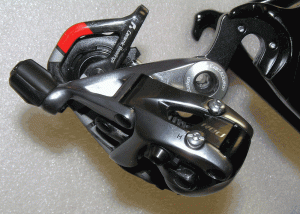 ith trying to remember which lever does what. The levers have been redesigned for better comfort and ergonomics. The brake lever has been extended and reshaped. The hoods themselves have also been reshaped for better feel, and are now easier to hold.
ith trying to remember which lever does what. The levers have been redesigned for better comfort and ergonomics. The brake lever has been extended and reshaped. The hoods themselves have also been reshaped for better feel, and are now easier to hold.
The rear derailleur has been redesigned to allow for better integration with a 28 tooth cog, which our client has selected. A new, long cage version is forthcoming, allowing use of the Red derailleur with a 32 tooth rear cog. So, no more need to resort to a SRAM mountain bike derailleur to get lower gearing.
Despite their phenomenal performance, we elected not to use the SRAM RED 2012 brake calipers as there are lighter brakes on the market that work reasonably well. We elected to go with Zero Gravity, by Ciamillo. The design uses a cam actuation system, similar to some other light-weight brake calipers on the market today. This type of design allows for a high rate of travel of the pad upon initial brake application, but low leverage,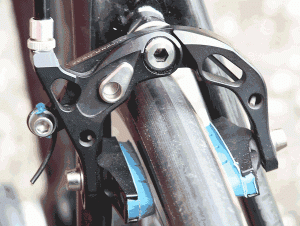 thus providing easy feathering of the brakes. As you squeeze harder, the leverage increases, while the distance decreases, thereby increasing braking pressure. These brakes vie for the title of lightest brake set on the market. They have an advertised weight of 133 grams for the set, sans pads and pad holders. This is almost half the weight of Shimano Dura Ace calipers. Even the new SRAM RED brakes, being very light, are 240 grams for the set. Campagnolo’s Super Record Skeleton brakes weigh in at 272 grams. So, as you can see, the Zero Gravity brakes are notably lighter. These brakes do not have the same feel or strength as a Shimano Dura Ace, or what is now arguably the class-leading SRAM RED 2012 brake calipers, but they do not feel mushy, and certainly provide more than adequate braking power.
thus providing easy feathering of the brakes. As you squeeze harder, the leverage increases, while the distance decreases, thereby increasing braking pressure. These brakes vie for the title of lightest brake set on the market. They have an advertised weight of 133 grams for the set, sans pads and pad holders. This is almost half the weight of Shimano Dura Ace calipers. Even the new SRAM RED brakes, being very light, are 240 grams for the set. Campagnolo’s Super Record Skeleton brakes weigh in at 272 grams. So, as you can see, the Zero Gravity brakes are notably lighter. These brakes do not have the same feel or strength as a Shimano Dura Ace, or what is now arguably the class-leading SRAM RED 2012 brake calipers, but they do not feel mushy, and certainly provide more than adequate braking power.
Despite weighing a little bit mo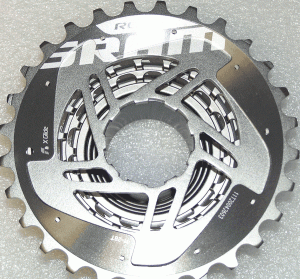 re, we wanted a wide range of gearing for the cassette so it would not be limited when climbing as that is where an ultra-light bike is at its best. We chose the SRAM RED XG 1090 cassette, with a range of 11-28 teeth, weighing in at 155 grams. The previous light-weight champ was what is now designated as the SRAM OG 1090 cassette, machined out of a single forged, hollow form. The problem with this old design was that the hollow and sealed chamber echoed; it was NOISY. With the newer cassette design, all of the cogs, except the smallest, are machined out of a single block of high grade tool steel. However, instead of having solid walls and back, as with the Power Dome, the new cassette is “hollowed out”, as you can see from the picture. The result is even lighter weight, and a much quieter drivetrain. SRAM has gone further in an attempt to quiet the drivetrain by including elastomers between each cog to further absorb noise. The result is a very quiet, very light cassette. The 11-28 cassette we installed in the bike weighs 155 grams. For comparison, a “Power Dome” weighs 165 grams and a Shimano Dura Ace 11-28 cassette we have in the shop weighs 185 grams. There is nothing exotic here, just a great shifting SRAM specific cassettes, and we saved 30 grams over the Dura Ace.
re, we wanted a wide range of gearing for the cassette so it would not be limited when climbing as that is where an ultra-light bike is at its best. We chose the SRAM RED XG 1090 cassette, with a range of 11-28 teeth, weighing in at 155 grams. The previous light-weight champ was what is now designated as the SRAM OG 1090 cassette, machined out of a single forged, hollow form. The problem with this old design was that the hollow and sealed chamber echoed; it was NOISY. With the newer cassette design, all of the cogs, except the smallest, are machined out of a single block of high grade tool steel. However, instead of having solid walls and back, as with the Power Dome, the new cassette is “hollowed out”, as you can see from the picture. The result is even lighter weight, and a much quieter drivetrain. SRAM has gone further in an attempt to quiet the drivetrain by including elastomers between each cog to further absorb noise. The result is a very quiet, very light cassette. The 11-28 cassette we installed in the bike weighs 155 grams. For comparison, a “Power Dome” weighs 165 grams and a Shimano Dura Ace 11-28 cassette we have in the shop weighs 185 grams. There is nothing exotic here, just a great shifting SRAM specific cassettes, and we saved 30 grams over the Dura Ace.
Next – crankset, bottom bracket and cables.

